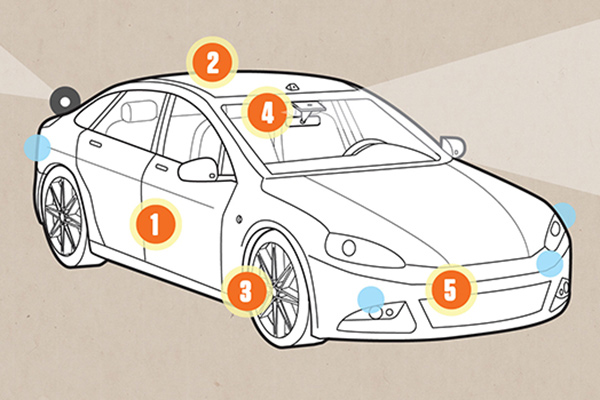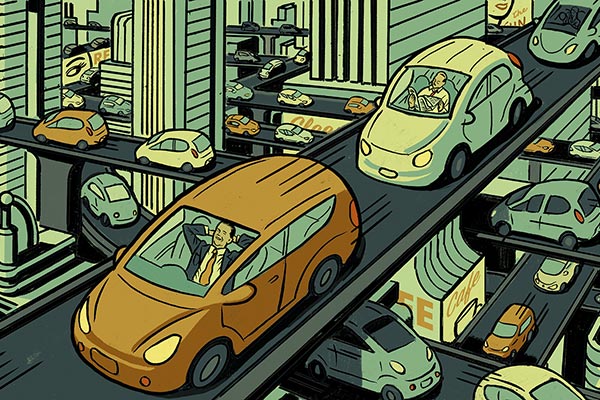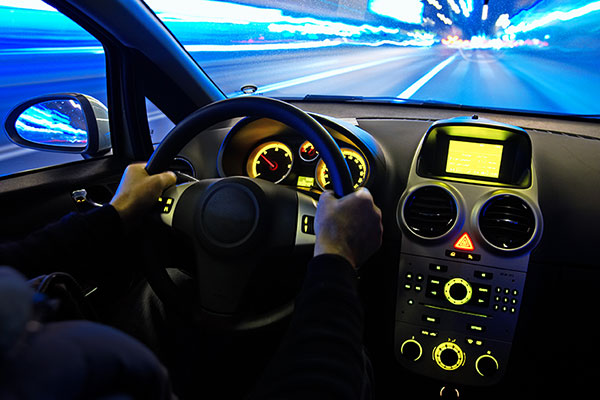Autonomous cars are already a reality—at least, they are in Phoenix, Ariz., where an autonomous vehicle company has partnered with a rideshare service. Its cars are already picking up and depositing riders—all without a human driver at the wheel.
While this has been a limited-scale project—in a city with normally good weather—being chauffeured around without a chauffeur is closer to becoming a common occurrence. The National Highway Traffic Safety Administration says that fully automated cars and trucks are on their way, 29 states have enacted legislation for allowing autonomous vehicles on their roads, and the U.S. Department of Transportation (DOT) recently announced plans to ease federal regulations surrounding autonomous vehicles.
The DOT’s rationale? Safety. As much as 94 percent of all serious automobile crashes are attributed to human error. Unlike human drivers, autonomous vehicles are not prone to distraction, fatigue or impaired driving.
So why aren’t we all buzzing around town in driverless vehicles? Why is it taking so long?
The Obstacles For Self-Driving Cars
There several issues that still need to be ironed out, say experts.
Weather
Just like a human driver, weather affects a driverless vehicle, says Melba Kurman, co-author of Driverless. If we can’t see in the fog, a camera can’t see in the fog, either—even an advanced camera that performs 360-degree scans up to 20 times per second and has deep-learning software to “teach” it to recognize objects.
However, that’s just one of the tools that autonomous vehicles use to “see.” There’s also LiDAR (light detection and ranging)—a sensing system that uses a spinning laser beam and calculates how long it takes for light to hit and then reflect back from an object. Cars also use radar, which measures radio waves to detect an object’s bearing, range and velocity.
Possible solution: Whether it’s LiDAR or better cameras that are used as the primary visual sensor, says Kurman, they are all feeding data into neural deep-learning networks and making autonomous driving systems smarter and better. “When companies are ready to invest in training driverless vehicles to handle snowy or foggy road conditions,” she says, “the cars’ performance will exceed that of a human driver.”
Liability & Insurance
This will be tricky, Kurman says, because if no one’s driving, who’s at fault if there’s an accident?
Possible solution: Policies and regulations will have to change to support the new technology—but they will, says Kurman. “Government and insurance companies will figure it out—after all, they’ve adapted to new technologies in the past.”
Non-standardized Road Markings
Signs and lights can vary by state—or even by municipality. Some traffic signals are horizontal, for example, while others are vertical. Plus, signs that mark the miles or exits along the highway aren’t the same from state to state, and if they’re damaged or old, they could be tough to read. If the car hasn’t learned all of the variables, there could be safety ramifications.
Possible solution: With artificial intelligence (AI) technology, computer-run vehicles are increasingly capable of learning at a rate far faster than humans. Eventually, cars will become smart enough that these variations won’t matter, says Paul Godsmark, chief technology officer of CAVCOE (formerly the Canadian Automated Vehicles Centre of Excellence), an Ontario-based nonprofit.
Recognition Of Objects
Road signs are one thing. But distinguishing between, say, a cat and a cardboard box—or a child and a small tree—can be tricky, and Godsmark says that companies are still working out kinks in image identification and classification.
Possible solution: With continued training, AI is getting better and better at recognizing objects—and is already better than humans in some circumstances, Godsmark says. AI is developing at an exponential rate, and any image-class problem that exists today might not be a problem in the near future.
Potential For Hacking
The cars’ computerized systems and the network of vehicles means that a security breach could have serious consequences. “When I go through things that would keep me up at night, this is at the top of the list,” Godsmark says.
Possible solution: “It gives me comfort,” Godsmark says, “that the tech companies leading autonomous-vehicle technology are world leaders in cyber security.”
Adoption Hesitancy
The handful of accidents involving autonomous vehicles have received lots of media attention; this could make people hesitant or unwilling to embrace autonomous vehicles.
Possible solution: If, say, 75 percent of people are unwilling to ride in a driverless vehicle, that’s good news, says Godsmark, because it means that 25 percent already are. “It’s a new technology and people are bound to be skeptical,” he says. “But once people try it, they’ll be won over.”
The Benefits Of Self-Driving Cars
Once the obstacles are overcome, these will be some of the benefits.
- Greater safety, less congestion. Driverless cars mean potentially fewer accidents, which can cause traffic backups.
- Environmentally beneficial. Autonomous vehicles will likely be smaller and electric-charged, rather than outfitted with fossil-fuel engines.
- Enhanced productivity. While you’re being driven to your destination, you can catch up on email and work calls—or do neither and take a nap.
- Greater independence. Older people and those with mobility issues will be able to remain self-sufficient by being able to easily travel to places like the grocery store, the movies or a restaurant.
Self-Driving Cars: How They Work
 You climb into your car, punch your destination into the GPS…and then curl up under a blanket for a nice nap while your vehicle drives itself there.
You climb into your car, punch your destination into the GPS…and then curl up under a blanket for a nice nap while your vehicle drives itself there.
Sound like a dream? Not quite.
With several manufacturers now developing technology for self-driving cars, many advancements are expected in the next few years. In fact, some experts have predicted that in our lifetime, we could be living in a world in which most cars on the roads will be driverless.
The basic components of self-driving cars already exist—they just need to be refined. Here’s a look at how most autonomous vehicles are wired.
1. Onboard Computer
Uses a neural network to process LIDAR and radar inputs.
2. Global Positioning System
GPS signals are combined with measurements from onboard meters for advanced location accuracy.
3. LIDAR Sensors
LIDAR (light detection and ranging) uses pulses of light to map nearby cars and objects
4. Hi-Def Cameras
Provide wide-range visibility to detect and identify traffic lights and road signs.
5. Forward-Facing Radar
Can detect other cars through inclement weather.
Wherever automotive technology goes, we’ll be there with solutions and savings. Speaking of which, now’s a great time to get a quote on auto insurance from GEICO and see if you could save!
Read more: 5 Hi-Tech Safety Features To Look For In A New Car
By Ellise Pierce and Mark Yarm










Debra says,
Excellent. Children can be driven to school. Elderly citizens and people who cannot drive can be more independent. Bar owners should have a fleet of driverless cars for those drinkers that don’t know when they’ve had enough. However, the impact on taxi’s and public transportation will be huge.
Ruben says,
Nice article, but,,. it should have being titled – Believe it or Not – self driving cars by 2020!
Within an ideal location like Disney World or similar “fantasy land” attraction parks I can see using self-driving electrical vehicles for specific applications. In this cases, this is old technology concepts used for many years to move people with trains and the likes of “it is a small world” rides. This concept has been in place for a long time.
I the real world that we live in today, I will address your question What do you think of self-driving cars? with other questions – Is GEICO going to insure me or my self-driving vehicle in 2020? If my self-driving vehicle is in an accident will the “your Honor I was not driving that vehicle plead” be valid? Would you really want your neighbors to have driverless electric vehicles in a school zone where you send your kids? Would GEICO be writing insurance policies for self-driving manufacturers against class-action suits. Would I need to renew my driver’s license ever again?
There is a lot of hype today and the Googles of the world have extra cash to burn, but does anyone really believe that there are going to be millions of self-driving vehicle in Miami, Manhattan and L.A. by 2020 or within our life time, if ever.
You have brought a good point of discussion on self-driving vehicles. We have autopilot features in most commercial airline planes today, but no one will fly in a plane without a pilot, fight engineer and co-pilot on-board. At best, driverless vehicles will simulate airplane technologic. But if anyone interprets self-driving vehicles to mean that they will be able to take a nap in your way to work or school you are living in “fantasy land”
We don’t live in “fantasy land”.
Nice article.
Seph Gordon says,
People used to think it was impossible for a car to go 40 mph. They used to think it was insanity to think that a thing could fly in the sky and transport people from one country to another.
In years to come we’re going to say, “People used to think it was impossible to have self-driving cars as the normal mode of transportation”.
Jonathan Pullen says,
Obviously there will be a period of transition. Ultimately, I am confident cars driven by computers – with senses like radar and lidar (not to mention 360 degree vision), the ability to communicate with each other, and a single-minded focus on the task at hand – combined with technologies like artificial neural networks – will be far safer than cars driven by humans. It will take us some time to get the bugs out, but it’s well worth doing. Among other things, these vehicles open up the possibility of no one actually having to own a car – you click a button on your app, and the vehicle of your choice arrives shortly thereafter. We’d no longer need huge parking lots at malls – in fact, in general, these vehicles could be told ‘go park’ and then summoned to the curb for loading.
Of course, they will probably only be a footnote in history as evolving battery technology and air traffic control makes hexacopter-style flying cars more and more practical. Of course, *those* will have some really interesting insurance problems. The hope is that they can be made redundant enough to not fall out of the sky if a motor, controller, prop, or battery fails, while still being made cheaply enough for us all to rent time on them. Only time will tell.
Pro-auto car says,
Can’t wait for a driverless car. It will even park itself. Stress free life! I do wonder about cost and liability. Google car tests showed that it’s cars driven by humans that cause accidents. So, what’s not to like about the autonomous cars? Grandma and grandpa, people with disabilities, people who do not like to drive can now sit back and relax?
Virginia says,
My brother has special needs and this would allow him to have greater independence. I’m excited – the dangers of everyone texting while driving or just driving badly has become par for the course, simply expected. This enhanced technology will cut down so many accidents from distracted drivers!
Richard Sanchez says,
ir’s time to go driverless. We could uae the time doing something else specially when it is bumper to bumper traffic.
DON GOOD says,
WOW!
PSmith says,
How does a driverless car see and react to the flagger at construction zones? Does it see the ambulance and pull over and stop? Does it see the DOT truck on the shoulder and move into the left lane? Does it see the EXIT CLOSED warning sign? Or the Bridge OUT sign? Does it see the yellow or red flashing lights on a school bus in the opposite lane? Does it see the shady area on the highway 1/4 mile ahead and knows it might contain black ice?
Carl says,
If the self driving car has an accident or kills someone, who is liable? Will one need a license to own a self driving car?
ray velazquez says,
i enjoy driving ,i do not know if iam ready to embrace the idea
sean says,
This is really interesting information on self-driving cars. It seems really far down the road, but if self-driving cars dominated the roadways, what effect would that have on auto insurance? In an ideal world, there would be no wrecks in these types of vehicles, so how would auto insurance companies evolve to meet whatever market needs existed?
Craig says,
I’m against self-driving cars. They would be thrown off by a paper bag blowing in their path. How can they anticipate the actions of another driver or pedestrian? Drivers make mistakes, but computers lack the judgment that humans have. Driving requires human judgment.
Wise Guy says,
I dont like the idea of the car taking over my Brakes. First they need to work on Tech for helping humans drivers prevent accidents and improve bad habits.
Like Sonar adjusted for speed to warn of tailgating!, Heads-up Night Vision to show obsticals beyond headlights (& in fog), Ultrasonic Deer chasers, and just simple Windshield Defrosters!
All stuff that has already been around yet never put into production.
A Heads-Up GPS could be great for teaching new drivers – “Too fast”, “Turn your blinker on”, ect.
Manuel Aponte says,
It is the future advancement in the car industry and it is excellent. But the biggest problem will not be the autonomous car. The biggest issue will be for the autonomous car sharing the roads we their peers man driven cars….
Harry of Carrollton, TX says,
The future of self-driving cars is an exciting prospect for me, since my vision restricts me to daytime only driving. And even then, I don’t like driving to unfamiliar places, but a self-driving car can make this fear mute, as well as allow me to travel at night. I can’t wait for the future to get here!